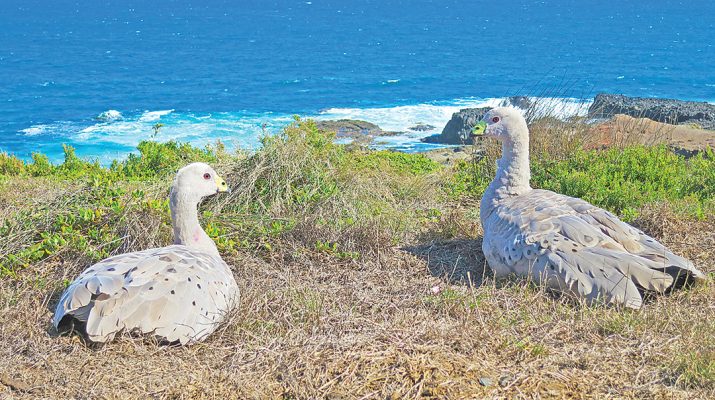Philip HOPKINS
FARMERS on Phillip Island are battling the damage done to agriculture due to the expanding number of Cape Barren Geese.
The Victorian Farmers Federation Bass president, Bill Cleeland, told the Phillip Island Advertiser that progress had been made in trying to stop the geese damaging farming.
“When we first started we could only get permits to scare and now we get permits (to cull) relatively quickly for a reasonable number,” he said.
Never the less, geese were continuing to damage pastures and cost money, with a flock of geese equivalent to a flock of sheep in terms of feed eaten.
“It costs us and other farmers thousands of dollars every year.”
Mr Cleeland said geese populations had exploded since Phillip Island had become fox-free, while wallabies and increasingly swamp hens were also causing damage to pastures and tree plantations.
“Geese and swamp hens also cause problems when they poo in water troughs, as they carry bacteria that can impact lambs and calves, whereas wallabies make it almost impossible to grow trees,” he said.
Mr Cleeland has been on a working group set up as part of a Wildlife Plan originally released in 2021 by Phillip Island Nature Parks, Bass Coast Shire, farmers and the state government. It detailed measures that aimed to balance populations of Cape Barren geese, wallabies and possums on the island.
The third update of the Phillip Island Wildlife Plan, which started in August last year as part of a Melbourne University PhD project, said 100 GPS loggers had been attached to the geese. A further 22 geese have been tagged with plastic neck collars, with a total of 200 to be attached this year, the Phillip Island Advertiser reported.
Results showed some geese had travelled almost 100 kilometres from Rhyll to a reservoir near Morwell, while others have reached Moe and Yanakie near Wilsons Promontory.
Most movements off Phillip island occur along the Bass Coast, between Lang Lang and San Remo. Six even visit French Island regularly, while one was tracked to near Tyabb on the Mornington Peninsula.
Many geese have shown a preference for specific farmers’ paddocks, often returning to the same locations many times.
The study found that geese numbers in the past year had totalled 3120 – 354 more that the 2023 survey.
The study, which began in May last year, will run until December 2027. It is investigating the geeses’ migratory and territorial behaviours, which in turn will help clarify their seasonal use of breeding and feeding grounds.
The Wildlife Plan was prompted by complaints in 2019 by farmers and other groups that geese were “pooing and chewing” their way through the landscape, with residents also reporting significant damage from swamp wallabies and brushtail possums.
The third update has shown that wallaby numbers on the Sutherland Peninsula have grown by about 750 to 1227 since the last census a decade ago, “with densities increasing from two to three individuals per hectare”.
Possum numbers on the Summerland Peninsula show a “high abundant” 2.3 per hectare, suggesting they have spread to a wide range of habitats across the island, even pen habitats without woodland.
A 12-month study of possum browsing on the health of eucalypts – using cameras to capture images – had sown that the majority of 16 swamp gums that had protective collars to protect them from possums had registered canopy growth.
The average survival rates of unguarded trees were one per cent after 12 months compared to survival rates of guarded plants averaging 44 per cent after 12 months.
“The findings emphasise the profound impact of browsing on conservation plantings,” the study said.
The wildlife plan showed that several proposed solutions to deter wildlife damage had failed. The use of decoy crops to relieve grazing pressure from Cape Barron geese had been ineffective.
Also, trials to evaluate commercial deterrents including Sen-Tree and D-Ter showed both products were ineffective at reducing the impacts of browsing by Cape Barren geese and wallabies. Seabird habitat, including erosion and collapse of burrows, had also been affected.
Exclusion fencing to protect six hectares of eucalypt plantation on the island had proven “extremely effective at safeguarding koalas” against the impacts of wallabies and possums, with a “floppy top” overhang design and “hot wires” to stop possums from gaining access.
The plan also hopes powerful owls on Phillip Island could prey on possums, with a single owl preying on up to 300 possums each year.
Successes include using possum carcasses for Aboriginal cultural practices, such as creating possum skin cloaks. Possums are “harvested humanely and sustainably”, and Bunurong Land Council will “continue to access possums for cultural use by the Bunurong community with the support of DEECA and Nature Parks”.
To improve the resilience of the Little Penguin colony, projects include 5.5 hectares of fire breaks and the planting of 12,415 plants across seven hectares, focusing on expanding tree canopy and shade coverage in penguin habitats. The Gap road wetland has had an extra 2000 plants planted across the eight-hectare site.
The Advertiser reported that a PhD candidate from Melbourne University, Vince Knowles, said little was known about the Cape Barren geese, especially on Phillip Island, where no formal study had been completed. Despite being common on the island, the geese had a small total range confined to the islands off southern Australia, he told the Phillip Island Conservation Society.
“Therefore it is vital to understand their basic ecology and biology so that the geese can be managed in a way that maintains a viable population, as well as minimising the effects they are currently having on agriculture and revegetation in conservation areas on Phillip Island,” he said


